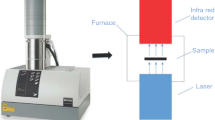Abstract
Inhibition effectiveness of dry chemical powders has been examined by detecting the temperature changes in the quenched flat-flame burner. A special particle delivery system was constructed to supply reliable particle concentration to a quenched flat flame. Particle evaporation phenomena in the flat flame environment was investigated by utilizing laser attenuation method which could determine the fraction of particle disappearance in the flame. The result from the flat flame inhibition experiments have clearly demonstrated that the ranking of effectiveness among KHCO3, NaHCO3, and NaCl reverses over the 1200–2000 K temperature range as flame suppressants. The results also showed that dry chemicals are effective inhibitor in the high temperature condition such as in the gaseous flame but not effective one in the coal flame of low temperature. It is concluded that, of all the experiment-specific flame properties, the maximum flame temperature at which the inhibitor evaluation is conducted, was a major parameter to determine the flame inhibition effectiveness in this work.
Similar content being viewed by others

References
Dolan, J.: “The Suppression of Methane/air Ignitions by Fire Powders”, Sixth Symposium (International) on Combustion, Reinhold, NY, 787 (1957).
McCamy, C., Shoub, H. and Lee, T.: “Fire Extinguishment by Means of Dry Powder”, Sixth Symposium (International) on Combustion, Reinhold, NY, 795 (1957).
Vanpee, M., Tromans, R. and Burgess, D.: “Progress in Astronatics and Aeronautics,15, 419 (1964).
Rosser, W., Inami, S. and Wise, H.:Combustion and Flame,7, 107 (1963).
Lee, T. and Robertson, A.:Fire Research Abstracts and Reviews,1, 107 (1963).
Dewitte, M., Vrebosch, J. and Van Tiggelen, A.:Combustion and Flame,8, 257 (1964).
Harpur, W.:Fire Journal,63, 38 (1969).
Grumer, J. and Bruzak, A.: “Inhibition of Coal Dust-Air Flames”, U. S. Bureau of Mines Report of Investigations 7552 (1971).
Woolhouse, R. and Sayers, D.:Fire Journal,67, 85 (1973).
Altman, R.: “Laboratory Evaluation of Dry Chemical Fire Extinguishants”, Western States Section Combustion Institute Fall Technical Meeting, El Segundo, CA(1973).
Babkin, V. and V’yim, A.:Combustion, Explosion and Shockwaves,7, 339 (1971).
Reuther, J.: “Measures of Effectiveness and Mechanisms for Chemical and Physical Inhibition of Quenched and Adiabatic Premixed Flames”, 10th Materials Research Symposium on Characterization of High Temperature Vapors and Gases, National Bureau of Standards Special Publication 561, 2, 1281 (1979).
Burgess, D., Hertzberg, M., Richmond, J., Liebman, I., Cashdollar, K. and Lazzara, C: “Combustion, Extinguishment, an Devolatilization in Coal Dust Explosions”, Paper 79-13, Western States Section Combustion Institute Spring Technical Meeting Provo, UT(1979).
Richmond, J., Liebman, I., Bruszak, A. and Miller, L.: “A Physical Description of Coal Mine Explosions. Part II”, Seventeenth Symposium (International) on Combustion, The Combustion Institute, Pittsburgh, PA, 1257(1979).
Hertzberg, M., Cashdollar, K. and Lazzara, C.: “The Limits of Flammability of Pulverized Coals and Other Dusts”, Eighteenth Symposium (International) on Combustion, The Combustion Institute, Pittsburgh, PA, 717 (1979).
Hertzberg, M., Cashdollar, K., Lazzara, C. and Smith, A.: “Inhibition and Extinction of Coal Dust and Methane Explosions”, U. S. Bureau of Mines Report of Investigations 8708 (1982).
Smoot, L. and Horton, D.: “Exploratory Studies of Flame and Explosion Quenching”, Volume 1, Final Report to the U. S. Bureau of Mines on Grant No GO177034 from Brigham Young University (1978).
Rahiman, S., Choi, T. and Essenhigh, R.: “Extinction of Coal Dust Explosion Flames by Additives”, International Conference on Coal Science, International Energy Agency, 593 (1983).
Baratov, A., Vogman, L., Kobar, Azatyan, V., Museride, M., Dzotsenide, Z., Petviashvili, D. and Namoradze, M.:Combustion, Explosion, and Shockwaves,12, 61(1977).
Iya, K., Wollowitz, S. and Kaskan, W.: “The Mechanism of Flame Inhibition by Sodium Salts”, Fifteenth Symposium (International) on Combustion, The Combustion Institute, Pittsburgh, PA, 329 (1975).
Mitani, T. and Niioka, T.: “Combustion of Experiments and Theory on Heterogeneous Flame Suppressants”, Nineteenth Symposium (International) on Combustion, The Combustion Institute, Pittsburgh, PA, 869 (1982).
Mitani, T.:Combustion and Flame,50, 177 (1983).
Friedman, R. and Levy, J.:Combustion and Flame,7, 195(1975).
McHale, E.:Combustion and Flame,24, 277 (1975).
Jensen, D., Jones, G. and Mace, C.: “Flame Inhibition by Potassium”, Journal of the Chemical Society: Faraday TransactionsI, 75:10, 2377 (1979).
Kaskan, W.: “The Dependence of Flame Temperature on Mass Burning Velocity”, Sixth Symposium (International) on Combustion, Reinhold, NY, 134 (1957).
Iya, S., Wollowitz, S. and Kaskan, W.:Combustion and Flame,22, 415 (1974).
Kaskan, W. and Reuther, J.: “Limiting Equivalence Ratio, Dissociation, and Self-Inhibition in Premixed, Quenched Fuel-Rich Hydrocarbon/Air Flames”, Sixteenth Symposium (International) on Combustion, The Combustion Institute, Pittsburgh, PA, 1083 (1977).
Cashdollar, K. and Hertzberg, M.: “Measurements of Particle and Gas Temperatures of Coal Dust Explosions and Flames”, Paper 29, Eastern States Section Combustion Institute Fall Technical Meeting, Miami, FL (1978).
Kim, H. T.: “Temperature on Particle Size Dependence of Sodium Bicarbonate Inhibition of Methane/Air Flames”, M. S. Dissertation, The Pennsylvania State University, PA, U. S. A. (1983).
Glassman, I.: “Combustion”, Academic Press, Inc., N. Y. (1977).
Lewis, B. and von Elbe, G.: “Combustion, Flames and Explosion of Gases”, Academic Press, Inc., N. Y. (1961).
Author information
Authors and Affiliations
Rights and permissions
About this article
Cite this article
Kim, HT. Inhibition effectiveness of dry chemical in methane/air flames. Korean J. Chem. Eng. 9, 1–7 (1992). https://doi.org/10.1007/BF02697405
Received:
Accepted:
Issue Date:
DOI: https://doi.org/10.1007/BF02697405



